
table of contents
- Poisonous trees from A to D.
- from E to F
- from G to H
- from I to R
- from S to Z
- frequently asked Questions
Trees are poisonous in comparison to others Poisonous plants Not so famous. There are 20 poisonous trees that are presented to you here. You may even have some of them in your garden.
In a nutshell
- various parts of the plant are poisonous
- Degree of poisoning depends on the plant
- Children are more susceptible to toxins
Poisonous trees from A to D.
Apricot (Prunus armeniaca)

- Poisonous: bitter kernels (amygdalin)
- Distribution: Mediterranean area and southwest Germany, Middle East via China to Japan
- Habit: upright, round crown, richly branched, lush green foliage, deciduous
- Height: 300 to 1,000 cm
- Spread: 200 to 400 cm
- Flower: white to pink, 2.5 cm in diameter, pleasantly fragrant
- Flowering period: March to mid-April
- Fruit: spherical, furrowed, tomentose-haired, yellow to red in color
- Location: full sun, sheltered from wind and rain, warm, humic, nutrient-rich, well-drained, suitable for rock gardens
Tree ivy (Hedera helix)

- Poisonous: in all parts of the plant, highest concentration in fruits
- Distribution: Europe to eastern Turkey, except for southern Norway and Sweden not in northern Europe
- Habit: creeping, climbing, on trees, woody trunk (tree ivy), adhesive roots, evergreen
- Growth height: 2,000 to 3,000 cm, in tree form mostly 1,000 cm
- Spread: depending on age, environment and climbing aids
- Leaves of young specimens: deep green, three- to five-lobed, palmate, medium-sized
- Age-form leaf: dark green, heart-shaped, slightly wavy at the edge
- Blossom: only from age, yellow-green, inconspicuous umbels
- Flowering period: September to the end of October
- Fruit: blue-black berries, densely arranged
- Location: shady to shady, sufficiently humid, moist soil, humic, rich in nutrients, adaptable
Note: Ivy only takes on its age form, which resembles a poisonous tree, from the age of eight to ten years. From this point on, the plant forms one or more trunks that make up the tree ivy.
Bitter almond (Prunus dulcis var. amara)
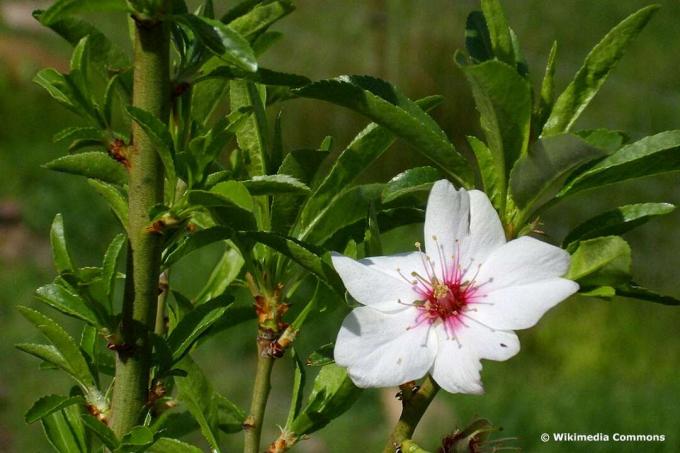
- Poisonous: Nuclei (amygdalin)
- Distribution: Western Asia from the Mediterranean to Southwest Asia
- Growth: upright, loose crown, deciduous
- Height: 200 to 1,100 cm
- Spread: 150 to 200 cm
- Leaf: green, elliptical, quite broad
- Flowers: white-pink to pink, single cupped flowers
- Flowering period: mid-March to mid-April
- Fruit: 3 to 5 cm long drupes, velvety hairy, leathery
- Location: sunny, warm, ideal in front of a wall or house wall, well-drained, sandy, nutrient-rich
Bottle Tree (Pachypodium lealii)

- Poisonous: Milky juice, used as an arrow poison
- Distribution: Namibia, southern Angola
- Habit: thick trunk, resembles a bottle, silver-gray basic color, differently branched in the upper area, armed with thorns, evergreen
- Growth height: up to 600 cm
- Spread: up to 200 cm
- Leaf: up to 10 cm long, green, shiny
- Blossom: sits at the end of the branch, white, plate-shaped, in clusters
- Flowering period: summer to autumn
- Location: sunny, warm (min. 15 ° C), permeable, mineral
- Special features: not hardy, ideal container plant
Boxwood (Buxus sempervirens)

- Poisonous: in all parts of the plant, highest concentration in leaves and bark
- Distribution: Central to Southwest Europe and North Africa to West Asia
- Growth: upright, dense, evergreen, well tolerated by pruning
- Height: 800 to 2,000 cm
- Spread: 200 to 400 cm
- Leaf: up to 2.5 cm long, dark green, glossy upper side, matt underside
- Blossom: inconspicuous, yellow-green, in clusters, pleasantly fragrant
- Flowering period: March to mid-May
- Location: sunny to partially shaded, protect from blazing midday sun, sheltered from the wind, likes lime, well-drained, moist
from E to F
European yew tree (Taxus baccata)

- Poisonous: Strongly poisonous in almost all parts of the plant, only the fruit coat is non-toxic
- Distribution: Azores over Europe and North Africa over Asia Minor to Iran
- Habit: upright, crown round to oval, multi-stemmed, appealing, evergreen
- Height: 1,000 to 2,000 cm
- Spread: 750 to 1,500 cm
- Leaf: light green needles, up to 3 cm long, pointed, soft
- Flower: green-yellow cones
- Flowering period: mid-March to the end of April
- Fruit: stone fruits, red fruit coat, one dark seed per fruit
- Location: shady to shady, sun is tolerated, urban climate-proof, undemanding, well-drained, calcareous, slightly loamy
Note: Other species of yew, such as the Japanese yew (Taxus cuspidata), are also poisonous and should be handled with care if you are keeping the trees as ornamental plants.
European euonymus (Euonymus europaeus)

- Poisonous: in all parts of the plant, highest concentration in the seeds
- Distribution: Europe to Asia Minor and the Caucasus
- Habit: upright, densely branched, cracked bark, windproof, deciduous
- Height: 300 to 600 cm
- Spread: up to 300 cm
- Leaf: 2 to 12 cm long, lanceolate or ovate, fresh green, bright red autumn color
- Flower: four-fold, inconspicuous, white to white-green
- Flowering period: mid-May to mid-June
- Fruit: purple to carmine red, four-lobed, up to 4 seeds
- Location: sunny to partially shaded, humic,
- Special features: poisonous even for insects, food plant for birds
Buckthorn (Rhamnus frangula)

- Poisonous: freshly formed bark, leaves, berries
- Distribution: Europe across the Caucasus to Asia Minor, Morocco, introduced into North America
- Habit: shrubby, small tree, irregularly branched, overhanging, twigs slightly hairy, deciduous
- Height: 200 to 400 cm
- Spread: up to 150 cm
- Leaves: broad, deep green, elliptical to ovate
- Flowers: white to light green, arranged in umbels, small, popular with pollinator insects
- Flowering period: May to mid-June
- Fruit: drupes, small, red to black
- Location: sunny to partially shaded, fresh, continuously moist to wet, dry soil is tolerated, acidic
from G to H
Common laburnum (Laburnum anagyroides)

- Poisonous: Highly poisonous in all parts of the plant, highest concentration in the seeds
- Distribution: South-Central to Southeastern Europe, grows near hop-beech forests (Orno-Ostryon) and wild service oak forests (Quercetum pubescenti-petraeae), deciduous
- Growth: as a small tree, upright, loose, overhanging
- Growth height: up to 700 cm
- Spread: 300 to 400 cm
- Leaf: green, triple-fingered, oval, long stem
- Flowers: resupinated panicle flowers, intense yellow, loosely pendulous
- Flowering period: mid-May to June
- Fruit: green-brown pods
- Location: sunny to partially shaded, loamy to sandy, fresh, moderately rich in nutrients
Common holly (Ilex aquifolium)
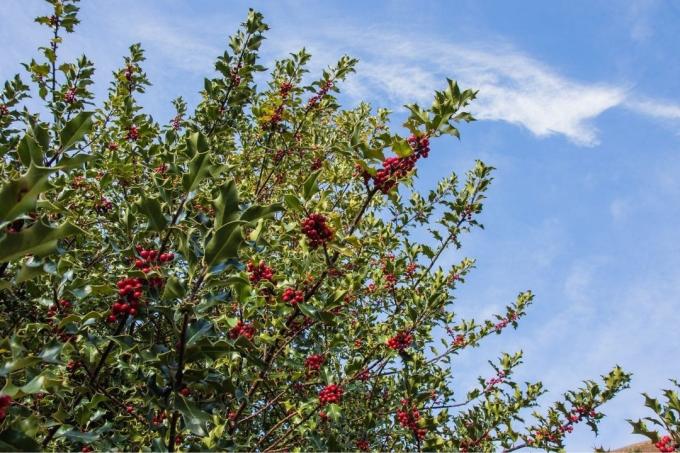
- Poisonous: Leaves, berries
- Distribution: Central and Western Europe, occasionally in Eastern and Northern Europe, rare in North Africa
- Habit: densely branched, upright, conical crown, evergreen
- Height: 1,000 to 1,500 cm
- Spread: 250 to 600 cm
- Leaf: ovate, toothed leaf margin, green, up to 1.5 cm long
- Flower: inconspicuous, radial symmetry, white to light red, small
- Flowering period: May to June
- Fruit: 8 to 10 mm drupes, spherical, red
- Location: shady to shady, sensitive to lime, loamy to sandy, humic, fresh, slightly acidic
Common nugget (Strychnos nux-vomica)
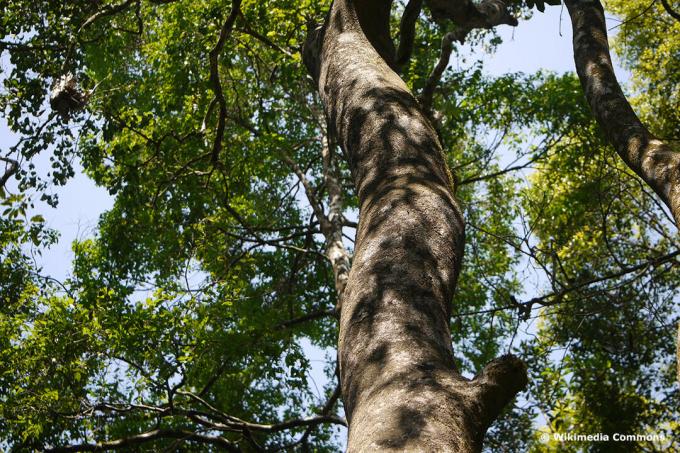
- Poisonous: in all parts of the plant (strychnine nerve poison), with the exception of flowers
- Distribution: India across Southeast Asia to Northern Australia
- Growth: upright, spreading, heavily branched, evergreen
- Growth height: up to 2,500 cm
- Leaves: dark green with pale green underside, 5 to 12 cm long, ovate
- Flower: inconspicuous, white to green-white
- Flowering period: over the winter
- Fruit: red, 3 to 5 cm large berries with 1.5 to 3 cm large seeds, up to 2.5 g in weight, gray-green to brown, burst when damp
- Location: dry, hot,
- Special features: seeds used to be used as emetics, not winter hardy
Common horse chestnut (Aesculus hippocastanum)
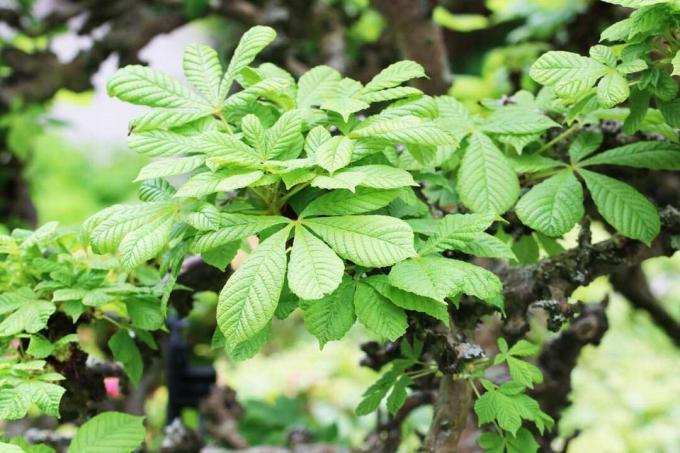
- Poisonous: in all parts of the plant
- Distribution: Home is the Balkan Peninsula, spread across Europe
- Habit: broad crown, tall, deciduous
- Height: up to 3,000 cm
- Spread: 1,500 to 2,000 cm
- Leaf: large, pinnate, green
- Flowers: large panicles, white, numerous
- Flowering period: April to the end of May
- Fruit: after 10 years at the earliest, green skin with thorns, up to 4 cm in diameter, brown in color with a light spot
- Location: sunny to shady, fresh, moist, sandy to loamy, well-drained, deep
- Caution: do not confuse it with the non-toxic and edible sweet chestnut (Castanea sativa)
from I to R
Indian cedar acacia (Melia azedarach)

- Poisonous: all parts of the plant
- Distribution: South to Southeast Asia
- Habit: fast-growing, richly branched, broad round crown
- Height: 600 to 2,000 cm
- Leaf: 2 to 7 cm long, dark green, ovate to elliptical
- Flowers: in panicles, white to red, pleasant fragrance
- Flowering period: March to mid-May
- Fruit: stone fruit, up to 1.5 cm in size, leathery, yellow
- Location: sunny to partially shaded, humic, well-drained
Arborvitae (Thuja occidentalis)

- Poisonous: Shoot tips (lead to contact dermatitis), bark, wood, cones
- Distribution: northeastern North America
- Habit: upright, conical crown, narrow, evergreen
- Height: 200 to 1,000 cm
- Spread: up to 300 cm
- Leaves: intense green, scale leaves
- Flower: small cones, female cones green, male red
- Flowering period: March to mid-May
- Fruit: seeds, 4 to 8 mm, red
- Location: sunny, tolerates partial shade, undemanding, moist, suitable for urban climates
Manchinelbaum (Hippomane mancinella)
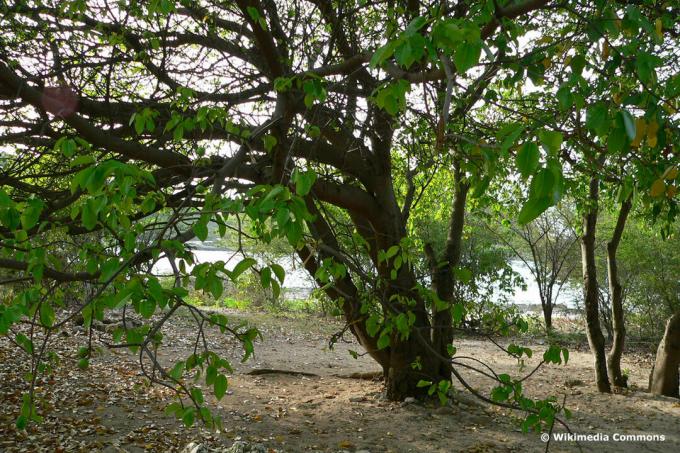
- Poisonous: Extremely poisonous latex in all parts of the plant
- Distribution: Florida, Caribbean, Bahamas, Central to Northern South America
- Growth: upright, richly branched, spreading, semi-evergreen
- Height: up to 1,500 cm
- Leaf: 5 to 10 cm long, ovate to elliptical, leathery or shiny, dark green
- Flower: spikes, 5 to 12 cm, green-yellow, inconspicuous
- Fruit: stone fruit, 2 to 5 cm in diameter, smooth, pleasantly fragrant
- Special features: is considered to be the most poisonous tree in the world, emits strongly irritating milky sap when it rains, corrosive fumes when burned
Purgier buckthorn (Rhamnus cathartica)

- Poisonous: Bark (for humans), fruits
- Distribution: Europe, Northwest Africa, Western Asia
- Growth: upright, sparse, with thorns, deciduous
- Height: 400 to 1,000 cm
- Spread: 300 to 600 cm
- Leaves: green, serrate margin, ovate to elliptical
- Flower: green, inconspicuous, in clusters, radial symmetry
- Flowering period: May to mid-June
- Fruit: stone fruit, small, spherical, black-purple
- Location: sunny to partially shaded, warm, undemanding, well-drained, lime-loving, ideal for rock gardens
from S to Z
Sand box tree (Hura crepitans)
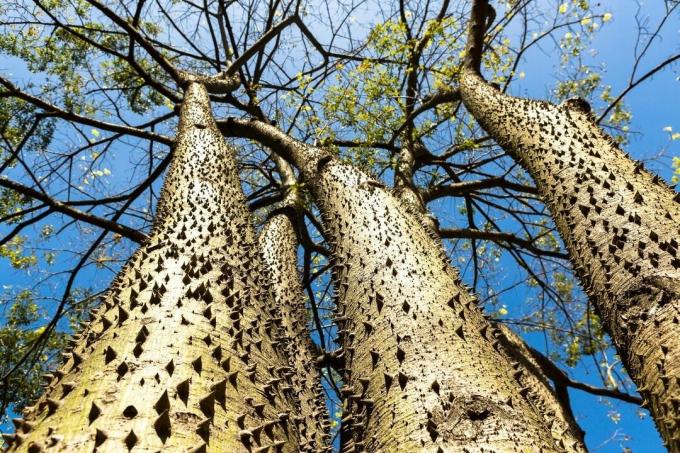
- Poisonous: Milky juice, is used as a poison for fish and arrows
- Distribution: Caribbean, Central America, South America
- Growth: upright, trunk diameter up to 200 cm, entire bark covered with 2 cm long thorns, evergreen
- Height: up to 4,000 cm
- Leaf: shiny, green, up to 20 cm long, hairy underside, heart-shaped, oval
- Flowers: brown-purple female single flowers in tubular shape, purple male spikes
- Fruit: round capsule fruit, 5 to 20 cm in diameter, red-brown
- Location: full sun to partial shade, moist, rich in nutrients
- Special features: not hardy, fruits open explosively, throw seeds up to 15 m
Mock acacia (Robinia pseudoacacia)

- Poisonous: Except for flowers in all parts of the plant, highly poisonous
- Distribution: western USA
- Growth: loose, umbrella or round crown, summer green
- Height: 1,200 to 3,000 cm
- Spread: 1,000 to 2,000 cm
- Leaf: green, pinnate, serrate leaf margin, ovate
- Blossom: white butterfly blossoms, arranged in clusters, intensely scented, attracts pollinator insects
- Flowering period: May to mid-June
- Fruit: pods, brown, up to 12 seeds
- Location: full sun to full sun, tolerates partial shade, undemanding, well-drained
Wonder tree (Ricinus communis)

- Poisonous: Seeds highly toxic (ricin)
- Distribution: northeastern Africa, Western Asia
- Habit: perennial as a tree or annual herbaceous, woody trunk, upright, evergreen
- Growth height: up to 1,000 cm
- Spread: up to 250 cm
- Leaf: large, palmate, colored red
- Flower: inconspicuous panicle flowers, yellow
- Flowering period: July to mid-October
- Fruit: prickly split fruit, 1.5 to 3 cm in size, contains silvery to red-brown shiny seeds
- Location: full sun, warm, nutrient-rich, well-drained
- Special features: not winter hardy
Note: Despite the toxicity of the wonder tree, the castor oil obtained from the plant is non-toxic. Due to its properties, it is used in a variety of areas, especially cosmetics and personal care.
Cerberus tree (Cerbera odollam)

- Poisonous: Milky sap in all parts of the plant, fruits with seeds are highly toxic
- Distribution: Southeast Asia, India, Pacific Islands, Australia
- Habit: upright, bushy crown, richly branched, evergreen
- Height: 200 to 1,500 cm
- Leaf: green, pointed, ovate
- Blossom: white funnel-shaped blossoms, single, large, sweetly scented
- Flowering time: over the summer
- Fruit: stone fruit, reminiscent of mangoes, up to 10 cm tall, red
- Location: sunny to partially shaded, nutrient-rich, well-drained
- Special features: not hardy, also known as the suicide tree
frequently asked Questions
The symptoms of poisoning from poisonous trees can be varied. Dizziness, headaches, nausea, diarrhea, and a dry mouth are common. Cramps, paralysis, breathing problems, organ damage, heart and circulatory disorders are also possible. Depending on the amount and intensity of the poison, comas or death can occur.
Contact the Poison Control Center and stay calm. Give water, tea or activated charcoal and avoid milk. Do not make the person vomit. Save vomit and parts of the plant to help identify the plant. In the event of severe poisoning, contact an emergency doctor or go to the emergency room. The poison control center can give you further assistance.
Be sure to wear gloves when cutting trees with toxic bark or milky sap. During the pruning operations, you can easily come into contact with these substances and injure yourself. You can easily dispose of cuttings and other waste from the poisonous trees on the compost. The toxins decompose with.
